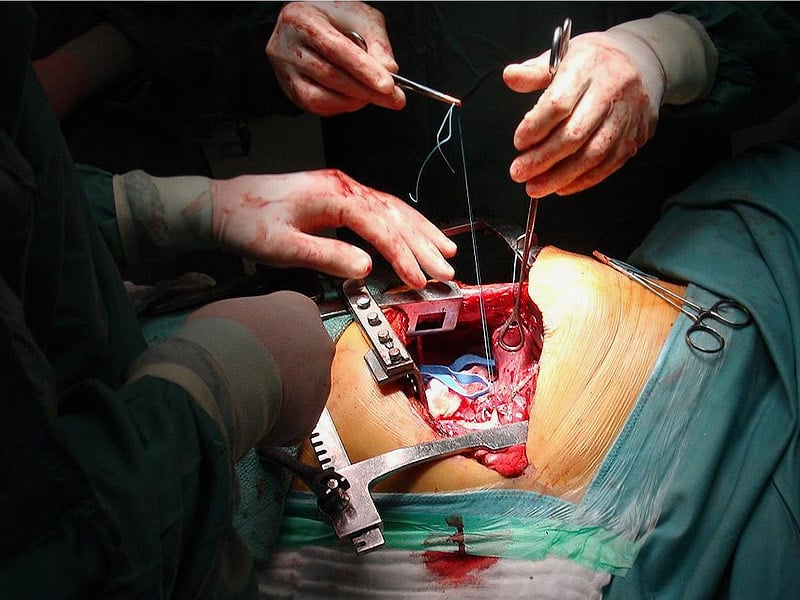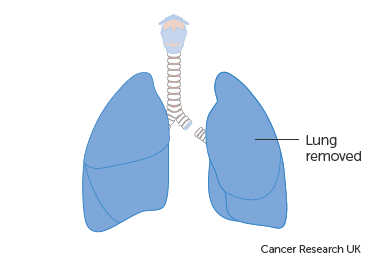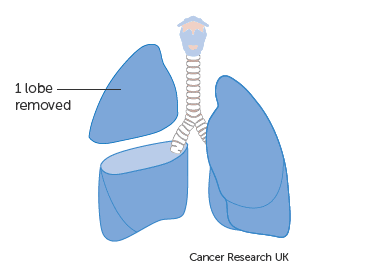Lung cancer is a malignant tumor of the lung that results in the uncontrollable growth of cells in the lung tissues. The growth of cancerous cells is spread by means of the lymphatic system to nearby tissues and organs in a process known as metastasis. For this reason, early detection and treatment of lung cancer is highly recommended. There are two main types of lung cancer namely: small-cell lung cancer (SCLC) and non-small-cell lung cancer (NSCLC). The most common symptoms of lung cancer are coughing, weight loss, shortness of breath and chest pains.

Surgery for Lung Cancer
Treatment Methods for Lung Cancer
Cancer of the lungs can be treated using a variety of methods depending on the location and size of the cancerous cells, whether or not cancer has spread, etc. Your doctor will perform some tests on you to determine the best course of treatment. Common treatments include palliative care, chemotherapy, radiation therapy and surgery for lung cancer.
1. Palliative care for Lung Cancer – This involves specialized medical and nursing care for people with lung cancer. It focuses on providing relief from the symptoms, chest pain, physical stress and mental stress. The goal is to improve the quality of life for you and your family in general. Specialist palliative care services see people with complex needs and can also advise other health care professionals. Contacting a specialist palliative care service soon after diagnosis gives them the opportunity to get to know you, your family and your circumstances. You can ask your treating doctor for a referral.
2. Chemotherapy for Lung Cancer – The chemotherapy regimen depends on the type and stage of lung cancer. Small-cell lung cancer (SCLC), even a relatively early-stage disease, is treated primarily with chemotherapy and radiation. In SCLC, cisplatin and etoposide are most commonly used. Combinations with carboplatin, gemcitabine, paclitaxel, vinorelbine, topotecan, and irinotecan are also used. In advanced Non-small-cell ( NSCLC), chemotherapy improves survival and is used as first-line treatment, provided the person is well enough for the treatment.
3. Radiation Therapy for Lung Cancer – This involves the use of radiation to destroy cancerous cells. Radiotherapy is often given in combination with chemotherapy with the intent to cure the disease.
Surgery for Lung Cancer
Another means of treating lung cancer is using surgery. Surgery to remove cancer (often along with other treatments) may be an option for early-stage non-small cell lung cancer (NSCLC). If surgery can be done, it provides the best chance to cure NSCLC.
Lung cancer surgery is a complex operation that can have serious consequences, so it should be done by a surgeon who has a lot of experience operating on lung cancers. If your doctor thinks the lung cancer can be treated with surgery, pulmonary function tests will be done beforehand to see if you would still have enough healthy lung tissue left after surgery. Other tests will check the function of your heart and other organs to be sure you’re healthy enough for surgery.
Types of lung surgery
There are different types of lung surgery depending on the section of the lung that is removed.
1. Pneumonectomy

Pneumonectomy
This surgery removes an entire lung. This might be needed if the tumor is close to the center of the chest. Before the lung is removed, your doctor will carry out preliminary tests to determine the pulmonary function of the other lung to ascertain it will be sufficient to enable you to breathe properly. Normally, a single non-defective lung is sufficient for breathing.
2. Lobectomy

Lobectomy
This involves the removal of one lobe of the lung. The lungs are divided into sections referred to as lobes. There are 2 lobes in the left lung and 3 in the right lung. The entire lobe containing the cancer is removed during lobectomy.
3. Segmentectomy/wedge resection – This involves the removal of a section of the lung. It is done to remove a localized portion of a diseased lung.
4. Sleeve resection – You might have an operation called a sleeve resection if your cancer is in the central area of the lung and growing into one of your main airways (bronchi). Your surgeon removes the affected section of the bronchus and any surrounding cancer in the lobe. This operation is not as common as other types of lung cancer surgery.
Surgical Techniques
The various procedures are carried out under general anesthesia. You will be asleep and unable to feel pain. Two common ways to do surgery on your lungs include thoracotomy and video-assisted thoracoscopic surgery (VATS).
1. Thoracotomy
This procedure is also referred to as open surgery. Your surgeon makes a cut that runs between two ribs. The cut will go from the front of your chest wall to your back, passing just underneath the armpit. These ribs will be separated or a rib may be removed.
After surgery, one or more drainage tubes will be placed into your chest area to drain out fluids that build up. These tubes are called chest tubes.
After the surgery on your lung, your surgeon will close the ribs, muscles, and skin with sutures.
Open lung surgery may take from 2 to 6 hours.
2. Video-assisted thoracoscopic surgery (VATS)
This method is a minimally invasive surgical technique. This procedure leads to much less pain and a faster recovery than open lung surgery.
Here, your surgeon will make several small surgical cuts over your chest wall. A medical device known as a laparoscope is used to look inside the chest. The laparoscope connects to a fiber optic camera. This shows pictures of the inside of the chest on a video screen. The surgeon puts the surgical instruments into the other cuts to remove cancer.
Lung Cancer Surgery Risks
Surgery for lung cancer is a major operation and can have serious side effects, which is why surgery isn’t a good idea for everyone. While all surgeries carry some risks, these depend to some degree on the extent of the surgery and the person’s health beforehand.
Some lung cancer surgery risks include:
- allergic reaction to anesthesia
- bleeding
- blood clots
- infection
- pneumonia
It’s important to discuss these risks with your doctor. Another possible long-term complication is shortness of breath with certain activities. This is especially true if you have a lung disease along with lung cancer (such as emphysema or chronic bronchitis).
Lung Cancer Surgery Recovery Time
Recovering from lung cancer surgery typically takes weeks to months. VATS recovery time is shorter compared to open lung surgery.
If your lungs are in good condition (other than the presence of cancer) you can usually return to normal activities after some time if a lobe or even an entire lung has been removed.
Lung Cancer Surgery Survival Rate
Lung cancer survival rates are a measure of how many people remain alive with lung cancer after a certain amount of time. For example, a five-year survival rate of 50 percent for a condition would mean that 50 percent of people, or 50 out of 100 people, would be alive after five years. Lung cancer survival rates depend on factors such as age, sex, smoking habits, and the presence of other medical conditions.
Lung cancer survival rates are as follows:
Stage 1 Non-Small Cell – The overall 5-year survival rate for stage 1A lung cancer is 49 percent and for 1B is 45 percent.
Stage 2 Non-Small Cell – The overall survival rate with stage 2A lung cancer is 30 percent and for stage 2B lung cancer, 30 percent.
Stage 3A Non-Small Cell – The overall survival rate for stage 3A lung cancer is 14 percent, but this varies widely among different cancers that are classified as stage 3A.
Stage 3B Non-Small Cell – The 5-year survival rate with stage 3B lung cancer is only 5 percent. The median survival time with treatment is 13 months.
Stage 4 (Metastatic) Non-Small Cell – The overall 5-year survival rate with stage 4 lung cancer is sadly only 1 percent to 2 percent. The median survival time is about 8 months.
Small Cell Lung Cancer – The overall 5-year survival rate for both stages of small cell lung cancer (limited stage plus extensive stage) is only about 6 percent. Without treatment, the average life expectancy for the extensive disease is 2 to 4 months, and with treatment is 6 to 12 months.
Remember, these survival rates are only estimates – they can’t predict what will happen to any person.
Read More: Scalenectomy


